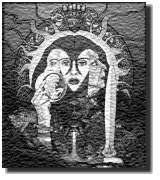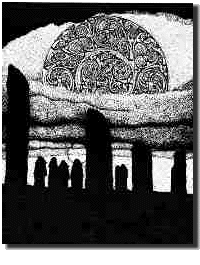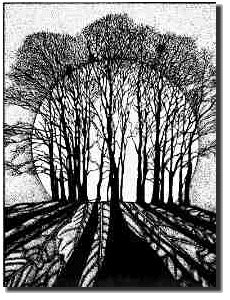
|
The Origins of
T�atha D� Danann |
 n
the fifth age of the world the divine race of T�atha D� Danann (peoples of the Mother
Goddes Danu) appeared upon the rich soils of our land, created from the Gods. The T�atha
D� Danann were divided into two groups, gods and non-gods, The gods were artisans,
artists, scribes, spiritual leaders, majik wielders, and aristocratic warriors, for they
possesd the power and talent of the race. The non-gods were farmers common labourers of
the fields. n
the fifth age of the world the divine race of T�atha D� Danann (peoples of the Mother
Goddes Danu) appeared upon the rich soils of our land, created from the Gods. The T�atha
D� Danann were divided into two groups, gods and non-gods, The gods were artisans,
artists, scribes, spiritual leaders, majik wielders, and aristocratic warriors, for they
possesd the power and talent of the race. The non-gods were farmers common labourers of
the fields. |

|
 he T�atha D�
Danann were a very talented and learned race of gods. They learned many arts and crafts,
along with majik. Their wisdom, their majik, and their four talismans gave them divine
power. The three greatest T�atha D� were Dagda the Good, Lug of the Long Arms, and Nuada
of the Silver Arm. Dagda earned his name because he was the god of fertility, and he
possesed great skill in majik. Lug, the god of the sun, emitted a great brilliance during
the day and reflected the glow of the sun from dusk until dawn. He and Dagda were the
greatest of the T�atha D� warriors. Nuada was the great druid of the T�atha D�. he T�atha D�
Danann were a very talented and learned race of gods. They learned many arts and crafts,
along with majik. Their wisdom, their majik, and their four talismans gave them divine
power. The three greatest T�atha D� were Dagda the Good, Lug of the Long Arms, and Nuada
of the Silver Arm. Dagda earned his name because he was the god of fertility, and he
possesed great skill in majik. Lug, the god of the sun, emitted a great brilliance during
the day and reflected the glow of the sun from dusk until dawn. He and Dagda were the
greatest of the T�atha D� warriors. Nuada was the great druid of the T�atha D�.
 he first
treasure of the T�atha D� Danann was Dagda's bronze Cauldron of Plenty, which always fed
each person the amount of food he or she deserved and yet satisfied the hunger of each
person who ate from it. Their second treasure was the Stone of Destiny, which foretold the
muses of the Fates. The third treasure was Nuada's spear, which always hit its target and
brought death to anyone it wounded. Their fourth and last treasure was the sword of Lug,
which flashed and roared with fiery flames and brought certain victory to whoever wielded
it. Lug's sword always longed for the taste of blood and searched for a way appease its
hunger. Lug kept its blade stored in a container of juice made from pulverized poppy
leaves, for the narcotic put the the sword safely to sleep until it was needed. Once Lug
unleased it, his sword would tear into the enemy and tirelessly slay warrior, feasting
upon their warm blood. he first
treasure of the T�atha D� Danann was Dagda's bronze Cauldron of Plenty, which always fed
each person the amount of food he or she deserved and yet satisfied the hunger of each
person who ate from it. Their second treasure was the Stone of Destiny, which foretold the
muses of the Fates. The third treasure was Nuada's spear, which always hit its target and
brought death to anyone it wounded. Their fourth and last treasure was the sword of Lug,
which flashed and roared with fiery flames and brought certain victory to whoever wielded
it. Lug's sword always longed for the taste of blood and searched for a way appease its
hunger. Lug kept its blade stored in a container of juice made from pulverized poppy
leaves, for the narcotic put the the sword safely to sleep until it was needed. Once Lug
unleased it, his sword would tear into the enemy and tirelessly slay warrior, feasting
upon their warm blood.
 y using
their great skill in majik the T�atha D� flourished their land with divine offerings,
and were determined to provide the earth with a consistent source of satiation throughout
the ages. The druids of the T�atha D� Danann--spiritual leaders of the tribe, carried
out the laborious task of seers over the earth and maintained their positions as
protectors of the forests and wild life. They were the priests, prophets, poets,
majicians, scientists, and doctors of their tribe. Experts in human knowledge, the druids
also could deal with the gods. They were so highly respected that they ranked next to
kings and chieftains in importance. The druids performed particular rituals and sacrifices
in the belief that they could persuade the gods who controlled the earth's forces to grant
their people fertility and prosperity. The druids were concerned with the cyclical pattern
of the earth and this alone was the key element in their teachings. Birth, Life, Death,
Resurrection, portrayed for the druids a sense of the world was and what was to be. Life
is born, is destroyed and it is reborn, recycled back into the world. It was very
important for the dead to be placed deep within the earth to be consumed and recycled for
the future. y using
their great skill in majik the T�atha D� flourished their land with divine offerings,
and were determined to provide the earth with a consistent source of satiation throughout
the ages. The druids of the T�atha D� Danann--spiritual leaders of the tribe, carried
out the laborious task of seers over the earth and maintained their positions as
protectors of the forests and wild life. They were the priests, prophets, poets,
majicians, scientists, and doctors of their tribe. Experts in human knowledge, the druids
also could deal with the gods. They were so highly respected that they ranked next to
kings and chieftains in importance. The druids performed particular rituals and sacrifices
in the belief that they could persuade the gods who controlled the earth's forces to grant
their people fertility and prosperity. The druids were concerned with the cyclical pattern
of the earth and this alone was the key element in their teachings. Birth, Life, Death,
Resurrection, portrayed for the druids a sense of the world was and what was to be. Life
is born, is destroyed and it is reborn, recycled back into the world. It was very
important for the dead to be placed deep within the earth to be consumed and recycled for
the future.

 he T�atha D�
Danann worshipped the sun, which represented light, fertility, and life. Their four major
holidays focused on the sun's relationship to the earth: the two solstices (summer, when
the sun is closest to the earth, and winter, when it is farthest from the earth) and the
two equinoxes (the beginning of spring and of autumn). They erected large a strange
monuments (which marks the sun's progress through the year) as a religious sight. For the
T�atha D�, life was a fragile matter and nature a harsh reality. The powers of darkness
brought freezing winter, long months when crops could not grow, and the risk of early
death from illness, starvation, or harsh weather to the land. The T�atha D�s year's-end
festival on the night before Samain (Halloween), was trulely a fearsome holiday because it
marked the beginning of winter, when the sun's power would become increasingly weak and
the forces of darkness would become increasingly strong. Survival was uncertain. he T�atha D�
Danann worshipped the sun, which represented light, fertility, and life. Their four major
holidays focused on the sun's relationship to the earth: the two solstices (summer, when
the sun is closest to the earth, and winter, when it is farthest from the earth) and the
two equinoxes (the beginning of spring and of autumn). They erected large a strange
monuments (which marks the sun's progress through the year) as a religious sight. For the
T�atha D�, life was a fragile matter and nature a harsh reality. The powers of darkness
brought freezing winter, long months when crops could not grow, and the risk of early
death from illness, starvation, or harsh weather to the land. The T�atha D�s year's-end
festival on the night before Samain (Halloween), was trulely a fearsome holiday because it
marked the beginning of winter, when the sun's power would become increasingly weak and
the forces of darkness would become increasingly strong. Survival was uncertain.

|
 amain
was a time of monsters and human sacrifice. As part of the religious festival, residents
of villages and towns would appear dressed as demons of darkness, disorder, destruction,
disease, and death so that the other residents could chase them away. The druids would
also construct figures representing these demons and burn them in town square as part of
the religious ceremony. The T�atha D� also sacrficed one third of their healthy children
to their gods every year, hoping to motivate the gods to provide the grains and grass that
they and their animals needed to survive. amain
was a time of monsters and human sacrifice. As part of the religious festival, residents
of villages and towns would appear dressed as demons of darkness, disorder, destruction,
disease, and death so that the other residents could chase them away. The druids would
also construct figures representing these demons and burn them in town square as part of
the religious ceremony. The T�atha D� also sacrficed one third of their healthy children
to their gods every year, hoping to motivate the gods to provide the grains and grass that
they and their animals needed to survive. |
 n the course of
time the T�atha D� Danann were celebrated throughout the land for the skills, and
majikal powers which brought about the protection and survival of all its inhabitants.
Their reclusive nature and often odd behavior often provoked fear and distrust among
certain people of the land, but were quickly dismissed by the greater powers of their
tribe. However, for many, the simple fact of just cathcing a glimpse at one of the T�atha
D� Danann was considered a blessing and often brought about good omens, fair and
prosperous tidings wherever they would appear. n the course of
time the T�atha D� Danann were celebrated throughout the land for the skills, and
majikal powers which brought about the protection and survival of all its inhabitants.
Their reclusive nature and often odd behavior often provoked fear and distrust among
certain people of the land, but were quickly dismissed by the greater powers of their
tribe. However, for many, the simple fact of just cathcing a glimpse at one of the T�atha
D� Danann was considered a blessing and often brought about good omens, fair and
prosperous tidings wherever they would appear.
-Stormcrow
TOP
Last modified: 11/27/98
This site is best viewed in 800 x 600, 16 million colors using Internet Explorer 4.x
All original
material (graphics & text)� 1998 Drak |

